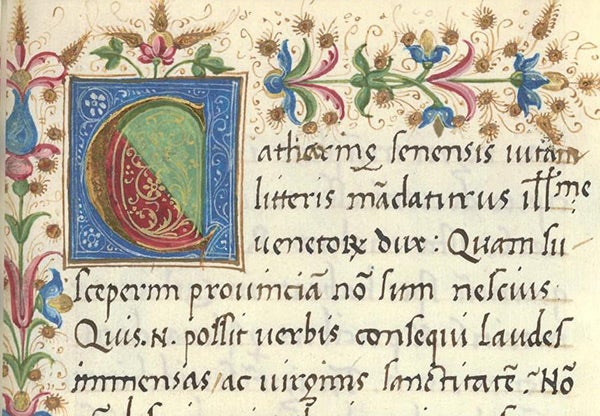|
September 27, 2012
Medieval exhibition spotlights Stanford Libraries' manuscript collection
Scripting the Sacred, a Stanford Libraries exhibition of Western European manuscripts and fragments, opened last week and continues through Jan. 6, 2013, in the Peterson Gallery and Munger Rotunda of Green Library. By Cynthia Haven

This manuscript is the working copy used by the Venetian printer Giovanni Tacuine for the first printed edition of 'The Life of Catherine of Siena.' (Photo: Courtesy Stanford University Libraries Special Collections)
For centuries, Bibles were painstakingly copied and lavishly illustrated, and then cherished from generation to generation. They became the focus of scholarly, creative and mystical activity for a millennium.
You can trace the Bible's literary history in Scripting the Sacred, a Stanford Libraries exhibition of Western European manuscripts and fragments. The exhibition, which opened Sept. 17, continues through Jan. 6, 2013, in the Peterson Gallery and Munger Rotunda of Green Library.
The exhibition features about 75 manuscripts and facsimiles – the latter are often valuable collectors' items in themselves, reproducing the shape and flaws of each medieval page. (Some facsimiles show works not included in the current Stanford collections.) Original works date from the ninth century to the 16th century. The exhibition also includes a few examples of the book's precursor – Greek and Egyptian fragments from the Stanford Libraries' papyrus collection, dating from around the third century B.C.
The exhibition includes early musical notation, books of hours, hagiographies and texts from such early church fathers as Origen, Augustine and Gregory the Great. Typical is a manuscript of The Life of Catherine of Siena, open to the lavishly illustrated frontispiece, circa 1500, previously owned by the 74th Doge of Venice, and a rare, pristine Dialogues by Gregory the Great, owned by Philippa of Guelders, the Duchess of Lorraine and Queen of Sicily. Several elaborate books of hours have illustrated devotions that "strengthen the association between text and temporality, as turning the pages of a book of hours parallels the unfolding of time and the passing of seasons," said Kathryn Dickason, co-curator of the exhibition with David Jordan.
The Stanford Libraries are the hub of the manuscript community at Stanford, thanks to its acquisitions, digital projects, grant-funded research, and programs and events such as this one. Stanford Libraries' digitization of the manuscripts of the Matthew Parker Library at Corpus Christi College, Cambridge – perhaps the first such large-scale online library of high-resolution images – has spurred a greater interest in medieval studies at Stanford.
According to Stanford Librarian Michael Keller, "The increase in research and teaching in ancient, medieval and early modern studies at Stanford in the recent few years is enormously gratifying to all of us, and particularly to our curators, archivists, 'digerati' and lovers of history. The simple fact that there are more medievalists and others joining the Stanford community is even more gratifying."
Scripting the Sacred is part one of a two-part exhibition. Part two, beginning in January, will feature secular manuscripts. Together, the exhibitions show almost all of Stanford's complete codices and most of its most important fragments.
The gallery is free and open to the public (first-time visitors must show ID). It is accessible whenever Green Library is open.
Cynthia Haven is associate director of communications for the Stanford University Libraries.
-30-
|